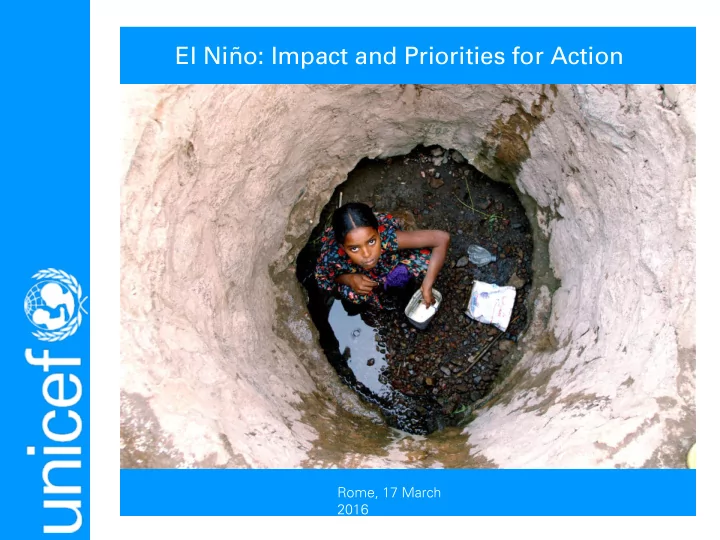

El Niño: Impact and Priorities for Action Rome, 17 March 2016
Overall Impact and Response - Pre-existing vulnerabilities compounded by El Nino-induced drought and torrential flooding. - Impact on women and children beyond nutrition and WASH - UNICEF’s support focused on a multi -sectoral response
Nutrition and WASH in Eastern and Southern Africa
Trends in SAM admissions in Eastern and Southern Africa (2013-15) 1,100,000 894,811 842,829 790,264 2013 2014 2015 TARGET for SAM in 2016
Eritre rea 13,0 ,000 Ethiopia pia 435,0 ,000 1 mi mill llio ion n Somali lia 108,8 ,800 chil ildren dren Kenya nya 56,0 ,000 Tanzania ia targeted for SAM 25,0 ,000 treatment Angola la in ESA in 2016 Eastern and Southern Africa Mala lawi i 37,8 ,800 65,0 ,000 Nutrition and WASH in Zimbabw bwe2 Madaga gasca scar Zambia ia 5,800 29,0 ,000 19,8 ,800 Mozambi bique que 72,0 ,000 Leso soth tho2 o2, 400
Nutrition Response Priorities Scaling up Nutrition Programming in line with government response plans Prioritizing improved data management systems Scaled up treatment of children u5 with SAM Promote and support appropriate infant and young child feeding practices Eastern and Southern Africa Supporting blanket supplementary feeding in Eritrea and Angola where WFP is not present. Nutrition and WASH in Promoting micronutrient supplementation
Eritrea 60,000 Ethiopia 5.8 16.6 .6 million mil illi lion on Somalia 2.8 million Kenya 500,000 People in Need of Water, Malawi Angola Sanitation & Eastern and Southern Africa 400,000 800,000 Hygiene Nutrition and WASH in Zimbabwe Response in ESA Madagascar 4.9 million 800,000 Swaziland 320,000 Lesotho 267,000
WASH Response Priorities Access to safe and adequate water supply Rehabilitation of rural water systems and/or establishment of new • water sources; Provision of WASH supplies including water treatment and jerry • cans WASH in Schools and Institutions Adequate and safe water available on school grounds and in health • clinics; Eastern and Southern Africa Alternative sanitary and hygiene facilities and adequate supply of • hygiene kits and soap available; Nutrition and WASH in WASH education and awareness raising sessions conducted in • schools, clinics and throughout communities; Prevention & treatment of water-borne diseases, incl. cholera Provision of potable water supply, hygiene and sanitation facilities • and supplies for the affected population. Support to Cholera Treatment Centres •
Nutrition and WASH in Latin America and the Caribbean
Haiti Hondura 3.6 million Guatemal s a 1.4 million 1.3 million 7.5 .5 mi mill llio ion El Salvador 825,000 Brazil Estimated 225,000 People in Need Bolivia of Humanitarian 30,000 Latin America and the Caribbean Peru Assistance in 23,000 LAC Paraguay 94,000 Nutrition and WASH in Uruguay 23,000 Argentina 30,000
Nutrition and WASH in the East Asia and Pacific Region
Mongolia 225,800 5.2 .2 mi mill llio ion Estimated Cambodi People in Need a 486,000 Marshall of Humanitarian Islands Viet Nam 15,500 Assistance in 976,000 EAP Nutrition and WASH in Papua New East Asia and Pacific Guinea 2.7 million Fiji Timor Leste 350,000 400,000
Summary of UNICEF’s Response Children receive the emergency therapeutic food and milk • they need to survive Basic health supplies, including vaccines, reach children • Children have access to safe water • The most vulnerable households receive food or cash • transfers to prevent children from child labor or begging Children can continue with their schooling in drought or flood • affected areas
The Way Forward Malnutrition and WASH concerns are gripping across the regions Multi-sectoral, integrated response is required. Focus on data-driven decision making. Reinforce national and local systems to preserve development gains. Address the staggering funding gap.
Recommend
More recommend